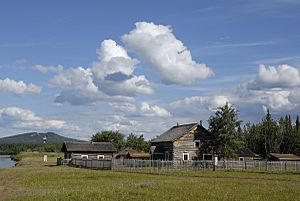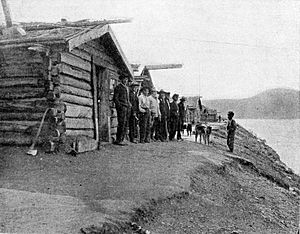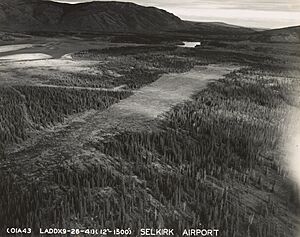Fort Selkirk facts for kids
Fort Selkirk is an old trading post located where the Yukon River and the Pelly River meet in Canada's Yukon territory. For a long time, it was the home of the Selkirk First Nation, who are also known as the Northern Tutchone people.
History of Fort Selkirk
People have lived in the area around Fort Selkirk for at least 8,000 years. This is known from old tools and other items found there.
In 1848, a fur trader named Robert Campbell started a trading post for the Hudson's Bay Company nearby. This company traded furs with First Nations people. In 1852, he moved the post to where it is now.
The Chilkat Tlingit First Nation did not like the Hudson's Bay Company trading in their area. They had their own traditional trade routes with other Athabaskan First Nations. So, on August 21, 1852, Chilkat Tlingit warriors attacked the trading post. They took many goods from the fort.
About 40 years later, the fort was rebuilt. It became a very important stop for supplies along the Yukon River.
In 1897, a man named Francis Joseph Fitzgerald made history. He was 28 years old and worked for the police. He was the first person of European descent to map a land route from Edmonton to Fort Selkirk. This long journey went through northern British Columbia and along the Pelly River. The trip took eleven months and covered about 1,000 miles (1,600 kilometers). Because of this amazing achievement, Fitzgerald was promoted in 1899.
Fort Selkirk was mostly left empty by the mid-1950s. This happened because the Klondike Highway was built, which went around the fort. Also, fewer boats traveled on the Yukon River.
Restoring a Historic Site
Today, many of the old buildings at Fort Selkirk have been fixed up. The Fort Selkirk Historic Site is now looked after by two groups. These are the Selkirk First Nation and the Yukon Government's Department of Tourism and Culture.
You cannot drive to Fort Selkirk by road. Most visitors arrive by boat, traveling on the river. There is also a small airstrip, called Fort Selkirk Aerodrome, at the site for planes.




